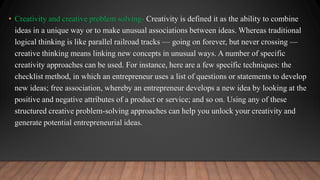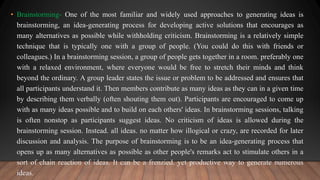Extension
- 1. IDEA GENERATION SUBMITTED BY: AKASH SINGH SOARES
- 2. Entrepreneurs need ideas to start and to grow their entrepreneurial ventures. Generating ideas is an innovative and creative process. Where Ideas Come From- Various entrepreneurship researchers have looked at the source of an entrepreneur's ideas. These studies have shown that the sources of their ideas are unique and varied. Common sources; 1. Personal interests or hobbies 2. Entrepreneur's work experiences, knowledge, and skills. 3. Look at products and services currently available. 4. External environment.
- 3. • Environmental scanning- One technique that entrepreneurs can use to generate ideas is environmental scanning, the screening of large amounts of information to detect emerging trends. Here are some "ideas" to stimulate your own idea creation by scanning the world around you: Read your local and other major metropolitan newspapers. Read popular consumer and news magazines; review the fiction and nonfiction best-seller lists; review government and consumer publications; subscribe to relevant trade publications; pay attention to commercials; watch and review top primetime television shows; browse through the magazine section of a bookstore; walk through a local shopping mall to see what's there; and so forth. The challenge of this method is not having too little information to scan: it's having too much. It may seem like a lot of effort and work, but if you're serious about being a successful entrepreneur in action, it's energy well spent.
- 4. • Creativity and creative problem solving- Creativity is defined it as the ability to combine ideas in a unique way or to make unusual associations between ideas. Whereas traditional logical thinking is like parallel railroad tracks — going on forever, but never crossing — creative thinking means linking new concepts in unusual ways. A number of specific creativity approaches can be used. For instance, here are a few specific techniques: the checklist method, in which an entrepreneur uses a list of questions or statements to develop new ideas; free association, whereby an entrepreneur develops a new idea by looking at the positive and negative attributes of a product or service; and so on. Using any of these structured creative problem-solving approaches can help you unlock your creativity and generate potential entrepreneurial ideas.
- 5. • Brainstorming- One of the most familiar and widely used approaches to generating ideas is brainstorming, an idea-generating process for developing active solutions that encourages as many alternatives as possible while withholding criticism. Brainstorming is a relatively simple technique that is typically one with a group of people. (You could do this with friends or colleagues.) In a brainstorming session, a group of people gets together in a room. preferably one with a relaxed environment, where everyone would be free to stretch their minds and think beyond the ordinary. A group leader states the issue or problem to be addressed and ensures that all participants understand it. Then members contribute as many ideas as they can in a given time by describing them verbally (often shouting them out). Participants are encouraged to come up with as many ideas possible and to build on each others' ideas. In brainstorming sessions, talking is often nonstop as participants suggest ideas. No criticism of ideas is allowed during the brainstorming session. Instead. all ideas. no matter how illogical or crazy, are recorded for later discussion and analysis. The purpose of brainstorming is to be an idea-generating process that opens up as many alternatives as possible as other people's remarks act to stimulate others in a sort of chain reaction of ideas. It can be a frenzied. yet productive way to generate numerous ideas.
- 6. • Focus groups- These groups of individuals provide information about proposed products or services in a structured setting. In a typical focus group, a moderator focuses the group discussion on whatever issues are being examined. For instance, a focus group might look at a proposed product and answer specific questions asked by the moderator. In other instances, the focus group might be given a moral general issue to discuss and the moderator simply leads the discussion based on comments made by the group- Either way, a focus group can provide an excellent way to generate new ideas and to screen proposed ideas and concepts.






